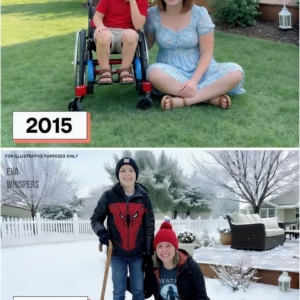When Patricia Williams gave birth to her son Redd in 2012, she never imagined that sharing his first baby photos would lead to confusion, cruelty, and eventually, a mission to change how the world sees difference.
Like most proud parents, Patricia and her husband, Dale, were thrilled to share pictures of their newborn. Redd was beautiful — soft white hair, porcelain skin, and striking blue eyes. The hospital staff gathered to take a peek at the baby with the snow-white hair, and Patricia thought little of it. She and Dale both had blonde hair, as did their older son, Gage. At first, it didn’t seem unusual.
But within weeks, Patricia began noticing things that didn’t feel right. Redd’s eyes moved rapidly from side to side, and he seemed overly sensitive to sunlight. One afternoon, as they sat in the living room, Dale searched the symptoms online. What he found changed their understanding of their child forever: Redd showed all the signs of albinism.
At first, Patricia didn’t believe it. She had never heard much about the condition, let alone seen anyone with it. But after visiting genetic specialists and an optometrist, the diagnosis was confirmed — Redd had Oculocutaneous Albinism Type 1 (OCA1), a rare genetic disorder that affects about one in 17,000 people worldwide. It impacts pigmentation in the skin, hair, and eyes, and often causes visual challenges.
Patricia remembered that as soon as she brought Redd home, his hair seemed almost luminous — so white it reflected light like glass. His eyes were so blue they appeared red under certain lighting. She assumed these traits might fade as he grew, but the specialists told her otherwise. Albinism wasn’t something to outgrow; it was a lifelong condition.
As Redd got older, the family faced reactions that ranged from curious to cruel. Strangers would stare or make comments about his appearance. On social media, people reposted his pictures with insensitive captions — calling him “grandpa baby” or “the child born old.” Some even turned his image into memes, mocking his white hair and pale complexion.
“It was devastating,” Patricia said. “You share your baby’s photo with love, and suddenly the internet is tearing him apart.”
When their second son, Rockwell, was born in 2018 — also with albinism — Patricia and Dale thought they were ready for anything. They knew how to protect his skin, manage his vision, and support his development. What they weren’t prepared for was the internet’s cruelty to strike again. Rockwell’s photos were taken without permission and spread across social media as jokes.
At first, the couple tried to contact people posting the images, asking them to take them down. But the internet moves fast, and they soon realized it was impossible to control. Instead of hiding, Patricia made a different choice — to speak out.
She began using her platform to educate people about albinism, sharing her family’s story not as a spectacle but as a source of understanding. “People didn’t mean to be cruel most of the time,” she said. “They just didn’t know what they were looking at.”
Through photos and videos, she showed the reality of raising children with albinism — the sun protection routines, the visual accommodations, and the everyday normalcy of their lives. Slowly, what began as a painful invasion turned into an opportunity for advocacy.
Patricia also worked hard to protect her sons emotionally. Redd struggled in school at first, often teased by classmates who didn’t understand why he looked different. His older brother Gage stepped in more than once to defend him. Eventually, after eye surgery to correct strabismus — a condition that caused his eyes to cross — Redd’s confidence grew. The surgery made a huge difference. Instead of patching one eye, which might have drawn more attention to him, they opted for the operation, allowing Redd to fit in more easily.
As he got older, Redd began to blend in, not because his appearance changed, but because his personality outshone everything else. His friends saw him as just another kid — funny, active, and capable of anything. He could run, play, and explore just like everyone else. The only difference was that he wore sunscreen, a hat, and dark glasses outdoors.
Rockwell followed in his brother’s footsteps, thriving in school and becoming the bright, charismatic child his parents always believed he’d be.
When Patricia shared a video of Rockwell dressed up for his school’s Western Day in 2023, it went viral again — but this time for the right reasons. The comments were full of love and admiration, with people calling him “adorable,” “handsome,” and “beautiful.” For once, the internet had turned kind.
Patricia used that moment to clarify one of the biggest misconceptions about albinism — that people with the condition have red eyes. “They don’t,” she explained. “Their eyes are actually blue, but because of the lack of pigment, certain lighting can make them appear red.”
Over time, Patricia became an unexpected advocate for albinism awareness. Her openness helped dispel myths, educate families, and connect her to a global community of parents facing similar challenges. She used what once caused her heartbreak as a tool to spread empathy and knowledge.
“I realized that people’s only exposure to albinism came from movies or myths,” she said. “They thought it was something strange or even scary. But when they saw my boys — laughing, playing, being normal kids — it changed everything.”
Today, both Redd and Rockwell are thriving. They’ve grown into confident, happy children who live life fully and without apology. They know who they are, and they’re proud of it.
Patricia still posts updates about their lives — not to chase attention, but to remind others that difference is not something to mock, but to understand. Her posts have inspired thousands, turning strangers into allies and ignorance into curiosity.
The same internet that once bullied her children now celebrates them. Photos that were once used as memes are now shared as symbols of resilience and beauty.
“I used to be angry,” Patricia admits. “Now I’m just grateful we could turn something ugly into something meaningful.”
Her family’s story is proof that education and empathy can change perceptions. What began with cruel jokes ended in community, awareness, and pride.
Redd, now a teenager, continues to prove that his condition doesn’t define him. He’s active, outgoing, and fearless — a kid who has faced the world’s cruelty and come out stronger. Rockwell, still young but full of confidence, mirrors that same spirit.
“People used to call them ‘the kids who look different,’” Patricia said. “Now, they’re just Redd and Rockwell — two boys who happen to have white hair and bright futures.”
In a world quick to judge what it doesn’t understand, Patricia’s family reminds us of something simple but powerful: beauty comes in many forms, and strength often starts with standing proud in your own skin.
What began as a story of mockery became one of awareness, love, and resilience — and it all started with a mother’s decision to turn pain into purpose.





